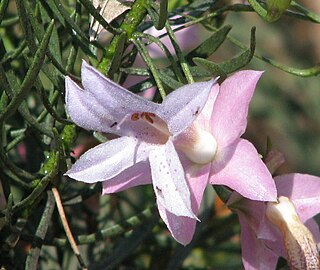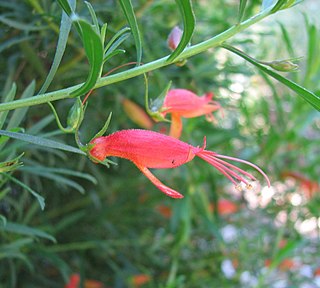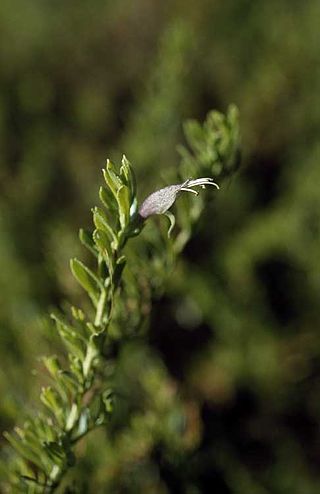
Eremophila abietina, also known as spotted poverty bush, is a plant in the figwort family, Scrophulariaceae and is endemic to a few arid areas of Western Australia. It is a stiff, upright, compact and very sticky shrub with distinctive, dark bluish-green leaves and pale coloured flowers spotted purple.

Eremophila decipiens, commonly known as slender fuchsia bush or narrow-leaved fuchsia bush is a flowering plant in the figwort family, Scrophulariaceae and is endemic to an area extending from the south-west of Western Australia to southern parts of South Australia. It is low, sprawling shrub with lance-shaped leaves and red, orange or yellow flowers on a long, S-shaped stalk.

Myoporum petiolatum, commonly known as sticky boobialla, is a plant in the figwort family Scrophulariaceae, and is endemic to the south-east of continental Australia. For many years this species has been confused with the much less common species Myoporum viscosum from which it can be distinguished by its thinner, noticeably petiolate and non-odorous leaves.

Myoporum turbinatum, commonly known as salt myoporum, is a plant in the figwort family, Scrophulariaceae and is endemic to a small area near Esperance in Western Australia. It is closely related to Myoporum platycarpum but has much narrower leaves and differently shaped fruit. Its sticky branches and narrow, warty leaves are distinctive.

Myoporum velutinum is a plant in the figwort family, Scrophulariaceae and is endemic to a small area near Esperance in Western Australia. It has similar flowers and fruits and grows in similar environments to Myoporum tetrandrum but differs from it and all other members of the genus by having hairs on the outer edge of the petals.
Glycocystis beckeri is the only species of the flowering plant genus Glycocystis in the family Scrophulariaceae and is endemic to the south west of Western Australia. It is a shrub, similar to others in the genera Eremophila and Myoporum but is unusual in that it produces very large amounts of sticky, sweet-smelling resin produced by raised glands which cover the entire plant, except for the petals. It has been suggested that the resin traps insects which the plant uses as a source of nitrogen.
Diocirea acutifolia is a plant in the figwort family, Scrophulariaceae and is endemic to a small area near Norseman in Western Australia. The branches and leaves produce sticky resin which sometimes covers the whole plant making it appear bluish grey. This species is distinguished from the three others in the genus by its leaves which are longer than 6 millimetres (0.2 in) and the prominent resin glands on its stems.

Diocirea microphylla is a plant in the figwort family (Scrophulariaceae), and is endemic to a small area near Coolgardie in Western Australia. It is a low shrub with thin branches and minute leaves pressed against the stems. It is readily distinguished from the other three species in the genus by its tiny leaves.
Diocirea ternata is a plant in the figwort family, Scrophulariaceae and is endemic to a small area near Balladonia in Western Australia. It is a low shrub with a restricted distribution but which often occurs in large numbers, forming a dense ground cover. It is readily distinguished from the other three species in the genus by its unusual leaf arrangement.
Diocirea violacea is a plant in the figwort family (Scrophulariaceae), and is endemic to a small area near Salmon Gums in Western Australia. It is a low shrub with a restricted distribution but which often occurs in large numbers, forming a dense ground cover. It can be distinguished from the three others in its genus by a combination of the size and arrangement of its leaves and the appearance of its fruits.
Eremophila aureivisca, also known as Rason poverty bush, is a flowering plant in the figwort family, Scrophulariaceae and is endemic to a small area in the south-east of Western Australia. It is a shrub with narrow, sticky, shiny leaves and pale purple flowers, known only from the edge of Lake Rason but may be more widely distributed in this remote area.
Eremophila conglomerata is a flowering plant in the figwort family, Scrophulariaceae and is endemic to central areas of Western Australia. It is an erect shrub with small, serrated leaves and mauve to blue flowers that extend well beyond the foliage.
Eremophila fallax is a flowering plant in the figwort family, Scrophulariaceae and is endemic to Australia. It is a densely-foliaged shrub with leaves which have a hooked tip and with blue to violet flowers. It occurs in South Australia and Western Australia. Without flowers, this species closely resembles Eremophila deserti but that species has 5 stamens and its fruits are a different shape.

Eremophila flabellata is a flowering plant in the figwort family, Scrophulariaceae and is endemic to Western Australia. It is a small shrub with serrated leaves, broad serrated sepals and pink, purple or mauve flowers.

Eremophila glutinosa, commonly known as sticky emu bush, is a flowering plant in the figwort family, Scrophulariaceae and is endemic to Western Australia. It is an erect, densely foliaged shrub with branches and leaves sticky and shiny due to the presence of resin. It has hairy sepals and lilac-coloured flowers.

Eremophila phyllopoda is a flowering plant in the figwort family, Scrophulariaceae and is endemic to Western Australia. It is an erect or spreading shrub, sometimes round or flat-topped with sticky, hairy leaves and flowers ranging in colour from pink or lilac to purple.

Eremophila pungens is a flowering plant in the figwort family, Scrophulariaceae and is endemic to Australia. It is an erect, sticky shrub with broad, serrated-edged leaves which end in a sharp spine and purple or violet flowers.

Eremophila spuria is a flowering plant in the figwort family, Scrophulariaceae and is endemic to Western Australia. It is an erect, open shrub with narrow leaves and blue, lilac, purple or white flowers and is a common and widespread species.
Eremophila succinea is a flowering plant in the figwort family, Scrophulariaceae and is endemic to Western Australia. It is an erect, broom-shaped shrub with sticky, narrow, hooked leaves, narrow, sticky sepals and hairy, pale purple or mauve petals.

Eremophila veneta, commonly known as metallic-flowered eremophila is a flowering plant in the figwort family, Scrophulariaceae and is endemic to Western Australia. It is a low, spreading, sticky shrub with dark green leaves and bluish-green petals.











